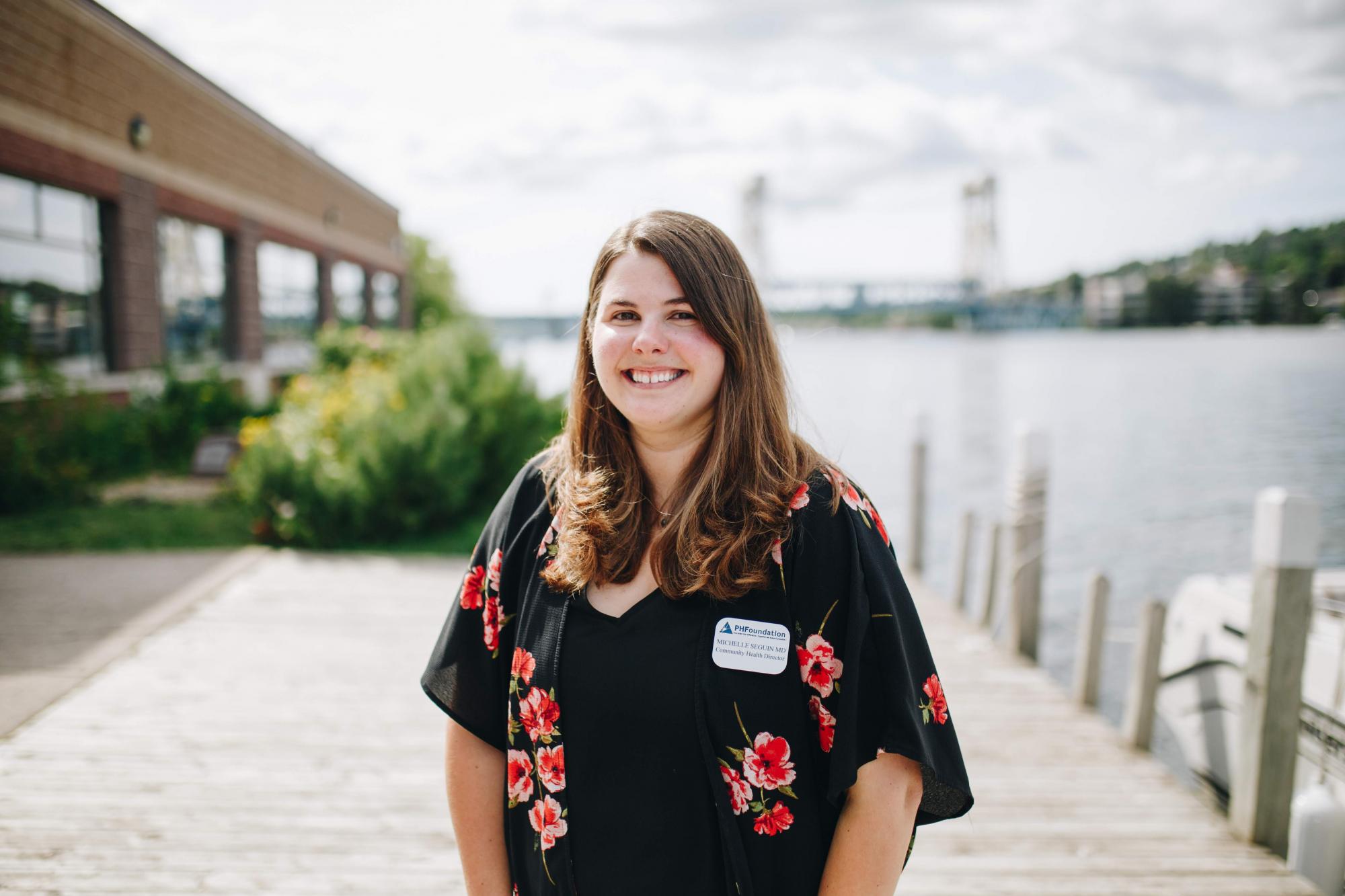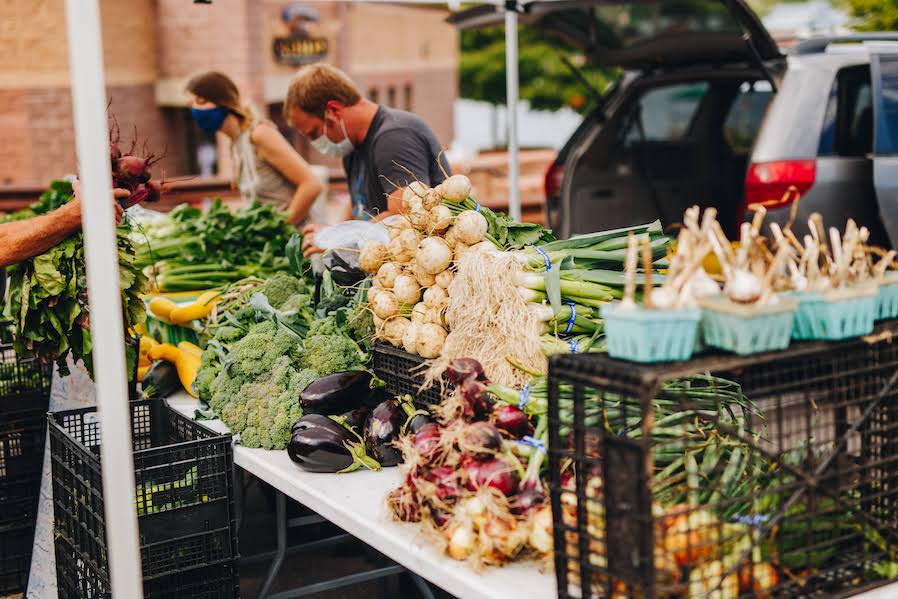When Dr. Michelle Seguin began building her practice as a family physician in the Copper Country, she was shocked by the amount of chronic disease she discovered. Through forming relationships with her patients, Seguin learned of many outside factors that impacted their health. One issue she discovered was food insecurity; a population of her community had limited access to nutritious food for various reasons.
According to October 2020 projections from Feeding America’s Map the Meal Gap study, there are approximately 57,000 people who are food insecure in the Upper Peninsula. That's about 18.9% of the population or 1-in-5 people facing hunger in the U.P. communities.
“It’s difficult to change your diet if you don’t have stable access to affordable and nutritious food. It’s hard to control your diabetes if you have to make a choice between filing a prescription and buying food for your family,” Seguin said.
 With the well-being of her patients and community as her inspiration, Seguin began tackling food insecurity head on. Currently, she resides as Director of Community Health for the Portage Health Foundation (PHF), whose mission is to support the charitable health needs of Baraga, Houghton, Keweenaw, and Ontonagon counties. Seguin is leading PHF’s efforts to more intently focus on the underlying social determinants of health and their influence on individual, population, and community health. Reducing hunger and poor nutrition is one of the organization’s long term strategic goals.
With the well-being of her patients and community as her inspiration, Seguin began tackling food insecurity head on. Currently, she resides as Director of Community Health for the Portage Health Foundation (PHF), whose mission is to support the charitable health needs of Baraga, Houghton, Keweenaw, and Ontonagon counties. Seguin is leading PHF’s efforts to more intently focus on the underlying social determinants of health and their influence on individual, population, and community health. Reducing hunger and poor nutrition is one of the organization’s long term strategic goals.
Since joining the organization in 2019, Seguin developed the PHF Food Initiative aimed at reducing hunger and poor nutrition across four rural U.P. counties. This resulted in the creation of 11 new community & school gardens; a collective Community Supported Agriculture (CSA) program connecting families at-risk for food insecurity with local produce; the expansion of Supplemental Nutrition Assistance Program (SNAP) and food assistance programs at area farmers markets and a virtual culinary medicine video series in partnership with a local library.
With September being Hunger Action Month, the mission to bring awareness and solution to food insecurity around the nation is highlighted on a more visible level.
“Work on the PHF food initiative is happening every day, year round, with an emphasis on expanding access to nutritious food and providing education and resources which promote sustainable changes to eating and lifestyle habits to all,” Seguin said. “We’re committed to supporting our food system holistically and comprehensively through efforts that increase local food production and distribution.”
Read on for more of Dr. Seguin’s first-hand account of bringing awareness and education to food insecurity issues in the Upper Peninsula.
Q&A
--
What drew you to working specifically with food insecurity issues in rural populations? What makes you so passionate about this work?
This was not a path I saw myself on when I went into medicine. I envisioned practicing family medicine in a small U.P. community for the duration of my career. My path shifted once I began building my practice and caring for patients in the Copper Country. The amount of chronic disease that I saw in my patients and their families was staggering. Through forming relationships and hearing their stories, I learned that there were factors in their lives that impacted health beyond what resources I had at my disposal as a doctor. My patients have inspired me to look beyond the walls of my clinic and work upstream addressing social determinants of health at the community level. Factors such as education, income, housing, food access, and transportation have been shown to be the greatest influencers of health beyond genetics and individual behaviors. In my humble opinion, it’s the unique attributes and the resources of the community that shape the health of the individual.
How has your previous work as a physician helped you in your work with the Portage Health Foundation?
In every single facet of this work I see a person impacted. I recognize the barriers that I experienced as a family physician and see how this work is helping to meet a need or fill a gap in our community. The impact isn’t measured in numbers or dollars, but in lives touched. I see my former patients in this work every day. I am working to make their lives healthier now, and that’s extremely gratifying.
Your current position as Director of Community Health with PHF helps advance your previous work with the Prescription for Health project. What was the inspiration for this project and what have you learned from it?
The Prescription for Health program is a produce subscription program that was implemented in 2017. During this time, I had established a primary care practice in a federally qualified health center in Houghton, Mich. Looking for opportunities to broaden my knowledge in lifestyle medicine and nutrition, I attended a conference in Traverse City hosted by the Groundwork Center. It was called Farms, Food, and Health. I learned about innovative programs which connected food and health systems across the state and the country. I was inspired by the idea of prescribing fruits and vegetables to my patients and was determined to bring it back to my practice.
 My clinic administration supported the program and I was able to secure funding for the pilot program through grants from the Portage Health Foundation and Blue Cross Blue Shield Foundation of Michigan. Approximately 30 adult patients were provided vouchers to purchase produce at the local farmers market for ten weeks throughout the summer. Participants received seasonal recipes, weekly nutritional education handouts, and health coaching by a community health worker. I looked at preliminary outcomes as a result of the program, and although there weren’t big changes seen in the physical biometrics, there was a statistically significant improvement in quality of life. For me that was a turning point, because as a doctor improving the lives of those we serve is at the heart of what we do. It shifted my perspective and put me on the path I’m on now.
My clinic administration supported the program and I was able to secure funding for the pilot program through grants from the Portage Health Foundation and Blue Cross Blue Shield Foundation of Michigan. Approximately 30 adult patients were provided vouchers to purchase produce at the local farmers market for ten weeks throughout the summer. Participants received seasonal recipes, weekly nutritional education handouts, and health coaching by a community health worker. I looked at preliminary outcomes as a result of the program, and although there weren’t big changes seen in the physical biometrics, there was a statistically significant improvement in quality of life. For me that was a turning point, because as a doctor improving the lives of those we serve is at the heart of what we do. It shifted my perspective and put me on the path I’m on now.
The patients also reported benefits of increased social interaction due to their visits to the market. They looked forward to getting out to the market every week. For many of them this was a new experience. They enjoyed being able to talk with the farmers and meet the people growing their food. This experience taught me that food is a conduit for connection. A seemingly small incentive can be a catalyst for change and can add up to significant improvements in well-being.
As these models become more widespread, we’re beginning to see how prescribing nutritious food can result in decreased healthcare expenditures. This is paving the way for potential reimbursement from CMS and other payers for these services.
In your experience, what are some common misconceptions or lack of information relating to food insecurity?
The biggest misconception is that hunger isn’t happening here. Around 75% of counties with the highest rates of food insecurity in America are in rural communities. When we look at the U.P. specifically, there are approximately 57,000 people who are food insecure as of October 2020, based on projections from Feeding America’s map the meal gap study. That's about 18.9% of our population or 1 in 5 people facing hunger in our communities. There are a lot of factors at play including underemployment, stagnant wages and rising cost of living, all contributing to circumstances where households may struggle to make ends meet. Food insecure households are often only food insecure temporarily due to unexpected life circumstances such as a sudden job loss, medical emergency, car breaking down, natural disaster, or in most recent times, a global pandemic. Many people seeking emergency food assistance in the past year did so for the first time in their lives. This was not a circumstance they chose or ever intended to be in. At the end of the day, food is for everyone. We all need to eat.
If you could name the most important, crucial piece of curbing food insecurity in the U.P., what would it be?
Raising awareness is the first step. The COVID-19 pandemic has brought this issue to the forefront across the country due to increased demand for emergency food assistance and supply chain disruptions. We all saw it in the grocery stores. Although it may not impact you directly, it is a public health issue that impacts the health of an entire community. Food insecurity impacts development and academic performance in children as well as raises the risk of chronic disease in adults, workforce absentee-ism, emergency department visits, hospitalizations, and total healthcare expenditures. All of these factors influence the health of a community collectively. The way forward is by responding collectively.
What do you feel are some steps that can be taken to improve food resources available in the Upper Peninsula?
Collaboration is key. Despite the challenges we face in rural communities, we have an abundant "foodscape". We need to connect people and the resources available in our communities. We are grateful for the roles oft emergency food assistance providers such as food banks and pantries, senior meals programs, and school-based food programs. Our region is uniquely positioned to make positive changes towards a healthier food system and communities through a shift to more local and regional food production and procurement. The U.P. has a rich agricultural history and it’s beautiful to see the revitalization in that sector. It’s a win-win situation where we are increasing local nutritious food access while also supporting our economy, which helps to improve the health overall of our people.
This progress that we are seeing now is years in the making and takes collaboration among many partners including the people growing our food. Long-term change will be achieved through collaboration and a systems-based approach that is driven by the community, for the community. We have the resources. We have the people. It’s the disconnection; we’re not getting the resources where they need to be.
September is Hunger Action Month. Is there anything special you are doing via PHF during this time? How can members of the community aid in the mission to end food insecurity?
Momentum is building in the Western U.P. We’re seeing an increase in the number of food producers in our region, increased attendance at our farmers markets, increased food assistance benefit dollars like SNAP and WIC utilization at our farmers markets. We saw the development of a mutual aid food sharing program in our region in response to the COVID-19 pandemic, as well as an increase in community and school-based garden infrastructure which is allowing more people to grow their own food and become actively engaged in their food system. We hope to make the healthier choice the easier choice for all.
Anyone that is interested in learning more about what we’re doing at the PHF Food Initiative is encouraged to visit our website and sign up for a quarterly newsletter for updates on our programming. We’re also always looking for new partners and collaborations, so feel free to connect with us at any time.
What is your connection with the Northern Michigan Center for Rural Health?
The Portage Health Foundation has partnered with the NMU Center for Rural Health in its efforts to promote rural health education. These efforts are important to help recruit and retain students who wish to pursue health careers here at home in the U.P. The NMUCRH has also assisted our efforts in measuring the impact of the work we are doing with targeted programming within the food initiative. Through the NMUCRH we are able to partner with academic institutions across the Upper Peninsula. This is an amazing asset for our organization as we implement and evaluate the impact of our community-based health programming locally now and in the future.
--
The Northern Michigan University Center for Rural Health seeks to improve the health and well-being of Upper Peninsula residents and communities by developing collaborative partnerships that enhance the access and availability of affordable, quality healthcare services. For questions or comments related to this story, contact ruralhealth@nmu.edu.
